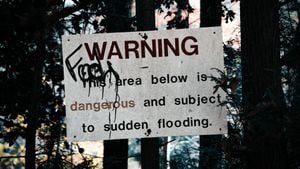Western Australia is poised for significant advancements in mineral exploration, thanks to new seismic data and innovative technologies developed through governmental and institutional support. With the global demand for minerals like lithium, nickel, and rare earth elements surging to unprecedented levels, these efforts are not just timely—they are absolutely necessary.
Recently, the Geological Survey of Western Australia (GSWA) announced its ambitious WA Array project, set to digitally transform the resource sector. This initiative, which has received $30 million over ten years, is one of the world’s largest passive seismic surveys. By utilizing 165 seismometers arranged across the state, the project aims to generate high-resolution geological maps, improving the ability of mining companies to locate valuable mineral deposits.
Western Australia’s Mines and Petroleum Minister, David Michael, stressed the importance of maintaining competitive advantages, stating, “Our freely available geoscientific data reinforces the State Government’s commitment to developing future mines.” This data is expected not only to attract investment but also to create thousands of jobs, thereby supporting the local economy as the world moves toward net-zero emissions.
Complementing this, the Australian Trade and Investment Commission (Austrade) has indicated its facilitating role by securing $11.5 billion of investments across 159 projects, which represent the highest investment value since 2010-11. These investments, projected to generate or preserve over 12,000 jobs, spotlight Australia’s becoming a favorable environment for mining and technology investments, particularly within the new energy sector.
But the drive for mineral exploration innovation doesn't stop there. One of the standout developments is the involvement of early-career researchers at the Commonwealth Scientific and Industrial Research Organisation (CSIRO), who are employing cutting-edge technologies to map Australia's mineral wealth. With research driven by the Discovery program, these teams are incorporating sustainable practices using advanced space-based sensors and 3D geological modeling.
Dr. Sandra Occhipinti, who leads this program, remarked on the significance of integrating new techniques to address the declining rates of resource discovery: “Our research supports Australia’s position at the forefront of mineral discovery and transitions to clean energy.”
Emerging researchers like Jo Miles, Mario Iglesias-Martinez, and Chirantan Parui are making significant strides. Miles operates with hyperspectral sensors aboard NASA's EMIT satellite, contributing to our knowledge of bedrock composition. Iglesias-Martinez, with extensive fieldwork experience, focuses on lithium-rich pegmatites, applying insights from his research worldwide. Meanwhile, Parui is innovatively modeling geological structures, emphasizing the need for accurate depictions of sedimentary basins to locate mineral deposits effectively.
Higher education is playing its part too. Universities are collaborating with mining businesses to implement research with real-world applications. The state government’s support through various funding initiatives aims to propel forward innovation among Mining Equipment, Technology and Services (METS) companies. The latest round of funds, amounting to $1.25 million, is set to bolster five METS projects focused on low-emission technologies and effective use of mining waste.
Among these projects is Total Mining Technologies’ automation system leveraging advanced AI-driven technologies. This innovative approach promises to optimize processing efficiencies significantly. Other participants include CMG Operations, which aims to develop next-generation airborne gravimeters, enhancing resource detection capabilities.
Such developments are reflective of Western Australia’s increasing commitment to sustainable practices and the mining industry’s transition to greener technologies. The demand for cleaner production and lower emissions weighs heavily on companies seeking to adapt to modern standards, fostering a climate ripe for technological investment.
Green Critical Minerals, another industry player, has gained attention for its groundbreaking developments around new graphite technology. This technology reportedly could revolutionize the graphite market by producing exceptionally high thermal conductivity and low electrical resistivity, ideal for battery applications.
Backed by research from the University of New South Wales, the technology's commercialization has led to rapid stock market interest, showcasing investors' enthusiasm for projects rooted deeply in innovation and market relevance. Shares recently surged by impressive percentages, highlighting the financial community's excitement around sustainable mining practices.
Meanwhile, the sector also faces external pressures, namely from environmental and regulatory frameworks aimed at safeguarding the local ecosystems and indigenous lands historically tied to mining activities. Stakeholders acknowledge these challenges, striving to balance economic benefits against sustainable practices. It’s clear this balancing act will define the future of mining and mineral exploration.
With the Australian mining industry showing resilience and adaptability, the potential for significant advancement is stark. The integration of seismic data, innovative research techniques, and technological advancements places Western Australia at the forefront of global mineral exploration. The upcoming GSWA Open Day on November 15, 2024, promises to reveal the processed data models, paving the way for future trendsetting practices within the sector.
Western Australia’s reputation as a major investment destination continues to solidify with the foundation laid by these forward-thinking initiatives and projects. It’s a transformative time for mineral exploration, one steeped in the promise of technological innovation and sustainable practices.



